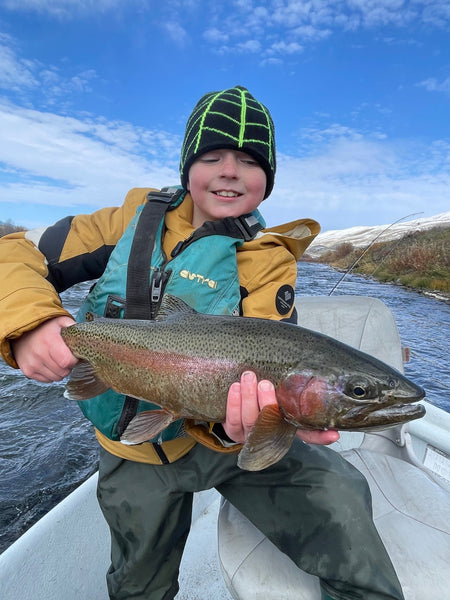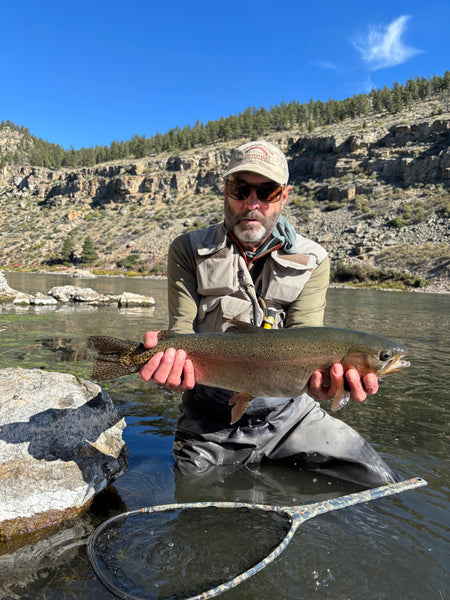Tips for Fishing The Firehole River Opening Weekend

Three tips for dry fly fishing on the Firehole
Yellowstone Park is about to open for fishing, which usually means the first consistent match the hatch dry fly fishing here in West Yellowstone. The Firehole River will soon have an abundance of insects and anglers pursuing the trout rising in its waters. Here are a few simple tips to get more out of your dry fly fishing.
Show up on time
There are a lot of good reasons to arrive at the river a good bit before you expect the trout to begin rising. While I do enjoy fishing wets before a hatch, the two biggest reasons to show up early have to do with the fish themselves.
Rising trout are almost always much easier to fool early in a hatch or spinner fall. The more natural insects they see, the more selective they usually become. A fish that will take any good drift with a reasonably close imitation when insects first appear may only take a very specific stage of the emergence later in the hatch. Trout also become more rhythmic in their feeding the longer they rise and less likely to break this rhythm to eat your fly when it drifts over. A trout that has been feeding for some time often requires not only a perfect drift but the exact fly at the exact time. Showing up in the middle of an emergence or spinner fall puts the odds in the trout’s favor and gives you less time to solve an increasingly difficult puzzle.
Showing up before the hatch begins gives you shots at easier fish as the insects first emerge and gives you more time to observe and react as the fish become more selective.

If you want to find larger fish feeding, don’t fish to the small fish
Any given morning in early to mid June, the Firehole will have a lot of fish feeding on the surface. This is why anglers flock there at this time. Most of these trout are 8-10 inches. A few push the 12-inch mark. Even fewer push into the teens. Most of the time I am content to fish dry flies to rising trout and could care less what size fish I am encountering. However, if you want to find these larger trout, you must hunt for them and ignore the many other fish that are coming to the surface. Slow, careful observation is key. You may only make a few casts in a morning if you set your sights high, but a sneaky 14 incher is a big reward on the Firehole.
Come to the stream with the right flies
Nothing is more frustrating than fishing an emergence, knowing what the trout are feeding on and not having a fly to match it. You don’t need a fly vest filled with flies to be prepared, but you do need to have some basics covered.

Spring on the Firehole sees two Mayflies. PMD’s and Baetis. PMD’s normally range from size 16-20 and Baetis range from 18-22. For emergences a Dun and an emerger to match these flies should have you covered. I like to carry a higher more visible dun pattern for rougher water and a slim, very realistic pattern for more picky fish. I don’t get too concerned about what style those patterns are. I’ve caught fish on Parachutes, No hackle Duns, CDC Duns, thorax Patterns, Comparaduns and many other types of patterns. You don’t need all of them because they all work. Just pick what you have confidence in and stick to that. At this point we need 3 different patterns in a few sizes to cover each Mayfly…. Not too bad. Throw in some PMD spinners and you should be all set for both morning and evening mayfly fishing.
There are a lot of different Caddis on the Firehole in the spring. The most common are the omnipresent White Millers that flit just over the water like moths most days. When the weather is crappy these bugs can be pushed onto the surface and trout do feed heavily on them at this time. A light tan caddis in 14-16 usually does the trick. Another common caddis is dark bodied in size 20. Tan or Cinnamon patterns in Size 16-18 usually match the other caddis I see.
Just like for Mayflies, I like to have a high floating pattern and a more realistic pattern along with an emerger to round out my box. However for Caddis on the Firehole a simple X-Caddis works 90 percent of the time if I don’t want to tie 3 flies for every possible insect I’ll see.
To match 95 percent of the insects you’ll see doesn’t require a gazillion flies, just a few of the right ones in the right colors and sizes.

These three simple things will help you get more out of your time on the water when you visit the Firehole this spring. Enjoy the beautiful scenery and the freely rising trout.
ABOUT MIKE LOEBL - PROFESSIONAL FLY FISHING GUIDE AT MADISON RIVER OUTFITTERS, WEST YELLOWSTONE, MT

Mike began fly fishing at the age of 7 in his home state of Michigan, where he would later start his career in the industry at a fly shop in Northville. Fast forward to the present and Mike has been with MRO for the better part of the past two decades. Not only is Mike a certified FFF casting instructor, but he is also well versed in both spey casting and Czech nymphing. As a guide, Mike loves to teach people new techniques and help improve upon what they already know. When not fishing, Mike can be found spending time with his wife Alice Owsley (also a fly fishing guide in the area) and their dog Norman.
Leave a comment
Comments will be approved before showing up.
Also in Madison River Fishing Report - Upper Madison River Fishing Report - Greater Yellowstone Area Fishing Reports

Madison River Outfitters Fishing Report for 10/21/2025
This is the Last Report of the Year! Have a Great Winter, and We'll See You All This Spring!!




Mike Loebl
Author